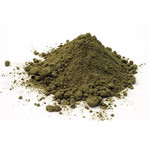Basic Slag
| Infobox on Basic Slag | |
|---|---|
| Example of Basic Slag |  |
| Facts | |
| Origin | - |
| Stowage factor (in m3/t) | - |
| Humidity / moisture | - |
| Ventilation | - |
| Risk factors | see text |
Basic Slag
Description
Basic slag is a by-product of the steel industry which, when finely ground, is used as a fertilser.
It is largely limestone or dolomite which has absorbed phosphate from the iron ore being smelted. Because of the slowly released phosphate content, and because of its liming effect, it is valued as fertilizer in gardens and farms in steelmaking areas. According to the American Association of Plant Food Control Officials, basic slag must contain at least 12% total phosphoric acid (P2O5) or be labeled "low phosphate".
Shipment / Storage / Risk factors
Usually packed in bags of paper or jute. Has a high density and will set hard if damaged by wetting. Slag so damaged may or may not have a value, dependent on the cost of drying, regrinding and rebagging. Contents are easily lost if bags become holed. Contact with acids gives rise to an offensive colour, which can be removed by drying, without loss of phosphate value unless the acid is toxic. See also Fertilisers, Phosphates and Superphosphates.











